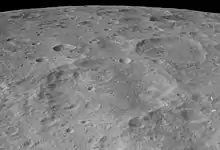 Apollo 16 mapping camera image (north is in upper right) | |
| Coordinates | 11°24′N 117°30′E / 11.4°N 117.5°E |
|---|---|
| Diameter | 92 km |
| Colongitude | 244° at sunrise |
| Eponym | Arnold H. Guyot |


Guyot is a lunar impact crater on the Moon's far side. It is separated from the crater Kostinskiy to the northeast by only a few kilometers of rough terrain. To the west-southwest lies the crater Lobachevskiy and to the east-southeast is Ostwald.
This is a worn and eroded crater with an outer rim that has been somewhat distorted in shape due to nearby impacts. Several small craterlets lie along the rim and the sides. The interior floor has also been marked by impacts, including an eroded formation occupying the northwestern portion.
The crater is named after the Swiss-born American geographer and geologist Arnold Henry Guyot. Prior to naming in 1970 by the IAU,[1] this crater was known as Crater 208.[2]
Satellite craters
By convention these features are identified on lunar maps by placing the letter on the side of the crater midpoint that is closest to Guyot.
| Guyot | Latitude | Longitude | Diameter |
|---|---|---|---|
| J | 8.3° N | 119.6° E | 14 km |
| K | 8.3° N | 118.7° E | 14 km |
| W | 14.0° N | 115.5° E | 21 km |
References
- ↑ Guyot, Gazetteer of Planetary Nomenclature, International Astronomical Union (IAU) Working Group for Planetary System Nomenclature (WGPSN)
- ↑ Lunar Farside Chart (LFC-1A)
- Andersson, L. E.; Whitaker, E. A. (1982). NASA Catalogue of Lunar Nomenclature. NASA RP-1097.
- Bussey, B.; Spudis, P. (2004). The Clementine Atlas of the Moon. New York: Cambridge University Press. ISBN 978-0-521-81528-4.
- Cocks, Elijah E.; Cocks, Josiah C. (1995). Who's Who on the Moon: A Biographical Dictionary of Lunar Nomenclature. Tudor Publishers. ISBN 978-0-936389-27-1.
- McDowell, Jonathan (July 15, 2007). "Lunar Nomenclature". Jonathan's Space Report. Retrieved 2007-10-24.
- Menzel, D. H.; Minnaert, M.; Levin, B.; Dollfus, A.; Bell, B. (1971). "Report on Lunar Nomenclature by the Working Group of Commission 17 of the IAU". Space Science Reviews. 12 (2): 136–186. Bibcode:1971SSRv...12..136M. doi:10.1007/BF00171763. S2CID 122125855.
- Moore, Patrick (2001). On the Moon. Sterling Publishing Co. ISBN 978-0-304-35469-6.
- Price, Fred W. (1988). The Moon Observer's Handbook. Cambridge University Press. ISBN 978-0-521-33500-3.
- Rükl, Antonín (1990). Atlas of the Moon. Kalmbach Books. ISBN 978-0-913135-17-4.
- Webb, Rev. T. W. (1962). Celestial Objects for Common Telescopes (6th revised ed.). Dover. ISBN 978-0-486-20917-3.
- Whitaker, Ewen A. (1999). Mapping and Naming the Moon. Cambridge University Press. ISBN 978-0-521-62248-6.
- Wlasuk, Peter T. (2000). Observing the Moon. Springer. ISBN 978-1-85233-193-1.